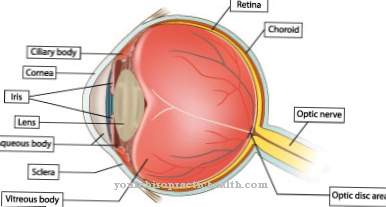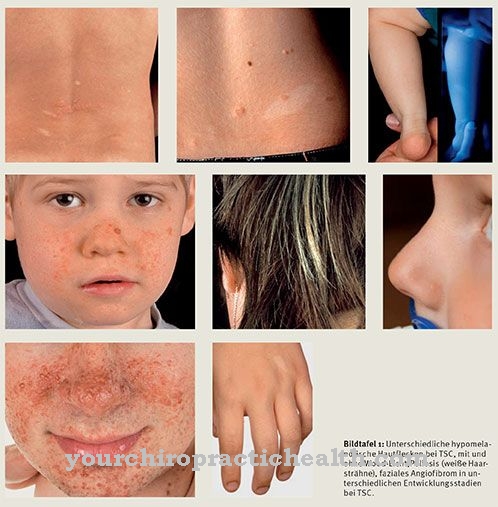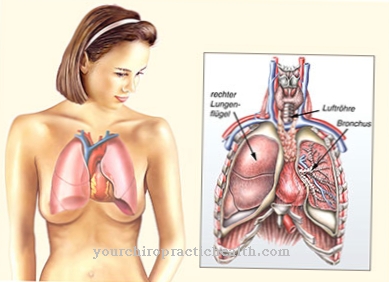All inflammatory processes that take place in the face and especially in the nerve-rich region of the nose and in the sensitive areas of the eyes are not only fraught with numerous risks. You are like that Lacrimal inflammation extremely uncomfortable and painful.
What is lacrimal inflammation?
Many people already have one Lacrimal inflammation gone through and are happy when the stressful symptoms finally subside.
In the context of the definition of the lacrimal gland inflammation, another term is used in medicine for the lacrimal gland inflammation, which is usually not familiar to the layperson. In this context it is about the synonym Dacryoadenitis.
The individual parts of the word are put together and individually mean on the one hand an inflammatory process and on the other hand a localization of the inflammation focus in the lacrimal gland.
In addition to the actual lacrimal inflammation, dacryoadenitis can also impair the tear duct.
causes
As causes for a Inflammation of the lacrimal gland Not only different pre-existing conditions come into consideration. Equally important are special external factors that lead to an inflammation caused by bacteria or dirt particles in an inflammation of the lacrimal gland.
When it comes to acute lacrimal inflammation, the causative factors mainly include infectious diseases and inflammation of the conjunctiva caused by bacteria or viruses.
In addition, injuries to the lacrimal gland can also cause lacrimal inflammation. The causes of the chronic lacrimal inflammation include tuberculosis, Hodgkin's disease and other blood diseases such as leukemia or sexually transmitted diseases such as syphilis and individual tumorous diseases.
Symptoms, ailments & signs
Since the acute inflammation usually only occurs on one side, the symptoms only show on one side. The conjunctiva on the inner corner of the eyelid of the affected eye turns red. The tissue on the outer corner of the eyelid swells, reddens and warms up and is very sensitive to pressure. Even the slightest touch causes pain.
Because of the severe swelling and pain, the upper eyelid can only be opened a little or not at all. This leads to a drooping lid, the appearance of which doctors refer to as paragraph form. The eye tears and secretes a watery or yellowish secretion that sticks the eyelashes together. When the inflammation has progressed, pus may be forced out of the lacrimal gland.
The secretion results in streaks on the eyes and vision can be impaired. The lymph nodes in front of the ear (preauricular lymph nodes) can swell. In addition, general symptoms such as fever, headache, nausea with vomiting, tiredness and fatigue can occur.
When the infection spreads to the conjunctiva, it feels like there is a foreign object in the eye. It scratches with every movement of the eye. The chronic form of the disease can occur on both sides and usually does not cause any pain, but the eye region swells much more than with the acute infection.
Diagnosis & course
Anyone who has ever had one or more Lacrimal inflammation knows how excruciating the symptoms are. The lacrimal gland inflammation can take on an acute, sudden appearance and heal again after a certain time, as well as a chronic, constantly recurring course.
With an inflammation of the lacrimal gland, the classic processes of an inflammatory process such as reddening and swelling of the affected and surrounding tissue, pain and warming of the area occur. However, an inflammation of the lacrimal gland does not have to be painful in every case. In severe cases of lacrimal inflammation, pus emerges from the lacrimal gland when you apply slight pressure.
For a meaningful diagnosis, in the case of lacrimal gland inflammation, in addition to assessing the symptoms, smears should be taken. These are largely relevant for the differential diagnosis of lacrimal gland inflammation.
Complications
Lacrimal inflammation usually heals without any major discomfort. Serious complications can arise when the patient's immune system is very weak. This can lead to pus formation in the affected eye and the development of an abscess.
As a result, eyesight deteriorates - visual disturbances and sometimes injuries to the eye can occur. If the course is severe, gastrointestinal complaints, headaches and high fever also occur. The permanent strain on the eyes can permanently impair vision. In the most severe case, the affected eye becomes blind.
The acute inflammation can turn into a chronic disease with recurring symptoms. This usually results in emotional problems for the person concerned. The visual flaw can cause social anxiety and thereby impair the quality of life of the person concerned.
With a comprehensive treatment, apart from any side effects of the prescribed drugs, there are no major complications. If appropriate medication is taken over a longer period of time, however, organ damage can occur. The risk of such a serious complication only exists in chronically ill patients who take antibiotics and painkillers, usually for months.
When should you go to the doctor?
Redness and swelling in the area of the eyes as well as increased flow of tears indicate an inflammation of the lacrimal glands. A doctor's visit is recommended if the symptoms do not subside within a few days. If there is inflammation or pus emerges from the bags under the eyes, an ophthalmologist should be consulted. In the event of an injury to the lacrimal gland, it is best to go to the doctor's office directly. In particular, people who come into contact with harmful substances at work or privately should consult a doctor if there are signs of lacrimal inflammation.
If dacryoadenitis is not properly treated, it can spread to the entire eye socket. In the worst case, the disease becomes chronic. During the treatment you should consult your ophthalmologist. The doctor must be informed about unusual symptoms and any side effects of the prescribed medication. The lacrimal inflammation should have subsided within two weeks. A protracted illness requires closer examination, as it may be caused by a serious illness that must first be treated before the inflammation can be treated.
Treatment & Therapy
For the treatment of the Lacrimal inflammation Varying funds are available. In the majority of applications, these include specifically selected drugs to initially relieve the acute symptoms.
For this purpose, in the case of lacrimal gland inflammation, medicinal substances to be taken by mouth, i.e. oral, or drugs to be applied externally are prescribed. For the treatment of the lacrimal gland inflammation from the outside, warm, preferably sterile compresses are prescribed as conditions with antibiotic substances or depending on the tolerability.
If specific pre-existing or concomitant diseases are suspected to be causative factors for an inflammation of the lacrimal gland, these should also be subjected to therapy. If viruses were found to be the cause of the lacrimal gland inflammation, which, for example, are also suspected in cold sores, the therapeutic measures are based on these findings.
If there are no infectious pathogens present in the lacrimal gland, treatment with prednisone is usually sufficient to reduce the swelling. The administration of preparations containing corticosteroids is considered to be the most important in the treatment of lacrimal inflammation. The therapy of dacryoadenitis is also about excellent hygiene in order not to spread infectious germs into the other eye or other facial areas (smear infection).
You can find your medication here
➔ Medicines for eye infectionsprevention
As a preventive measure against a Lacrimal inflammation In addition to the best possible cleanliness and avoidance of drafts and fine dusts, not too many preventive measures are known.
People who suffer from a condition that can be associated with dacryoadenitis seek medical treatment immediately. It is also helpful prophylactically to avoid inflammation of the lacrimal glands by not bringing pathogens into the eye area.
This often happens unconsciously, for example with herpes on the lips. When wiping your eyes, you should always work from the inside out. This procedure can also counteract the development of lacrimal inflammation.
Aftercare
There are no specific follow-up examinations that need to be performed after treating an inflammation of the lacrimal gland. The routine final visit to the doctor after the treatment or medication is sufficient in most cases. An important point to consider at the end of therapy is complete healing of the inflammation. This reduces the risk of chronic dacryoadenitis.
Patients are therefore advised to observe hygiene in the eye area and the entire face in order to make a recurrence of the lacrimal inflammation unlikely. Since the treatment is in most cases with antibiotics, patients can continue their everyday life as usual and without restrictions after successful completion of the treatment. In general, however, bowel rehabilitation may be necessary after therapy.
Because the active ingredients that get into the patient's body when taking antibiotics change the intestinal flora by reducing the number of healthy bacteria. As a result, further health problems can arise, as the immune system is weakened by the missing bacteria. Patients have the opportunity to rebuild their intestinal flora after antibiotic therapy with probiotic foods, for example, and thus to strengthen the entire immune system. This makes a chronic illness even less likely.
You can do that yourself
The most tried and tested home remedies are compresses that are soaked in soothing chamomile tea. It is important to only use real chamomile and not tea bags from supermarkets. A simple application of already cooled chamomile tea bags has an effect on the affected eye. Alternatively, fennel tea bags can also be used. Those affected can also use compresses with the medicinal herb eyebright. Eyebright drops are quicker and more effective.
Furthermore, those affected should also pay attention to their diet. For example, foods containing sugar and starch should only be consumed in moderation. These include particularly fatty meat, white bread and strong coffee. On the other hand, patients should prefer citrus fruits and low-fat fish. Fish oil in particular can support the function of the lacrimal glands and help them heal more quickly. Special fish oil capsules contain the important omega-3 fatty acids and help the inflammation to heal faster.
Eye exercises are also proven and very popular as home remedies. Patients should alternately carefully relax the affected eye and then move it afterwards. This should be done several times a day. Ideally, the eyes should be carefully moved up and down several times. Homeopathic remedies are also recommended. First of all, remedies such as Ledum palustre, Staphisagria, Apis mellifica, Rhus toxicodendron and Argentum nitricum are used.




.jpg)

.jpg)






.jpg)

.jpg)
.jpg)











.jpg)